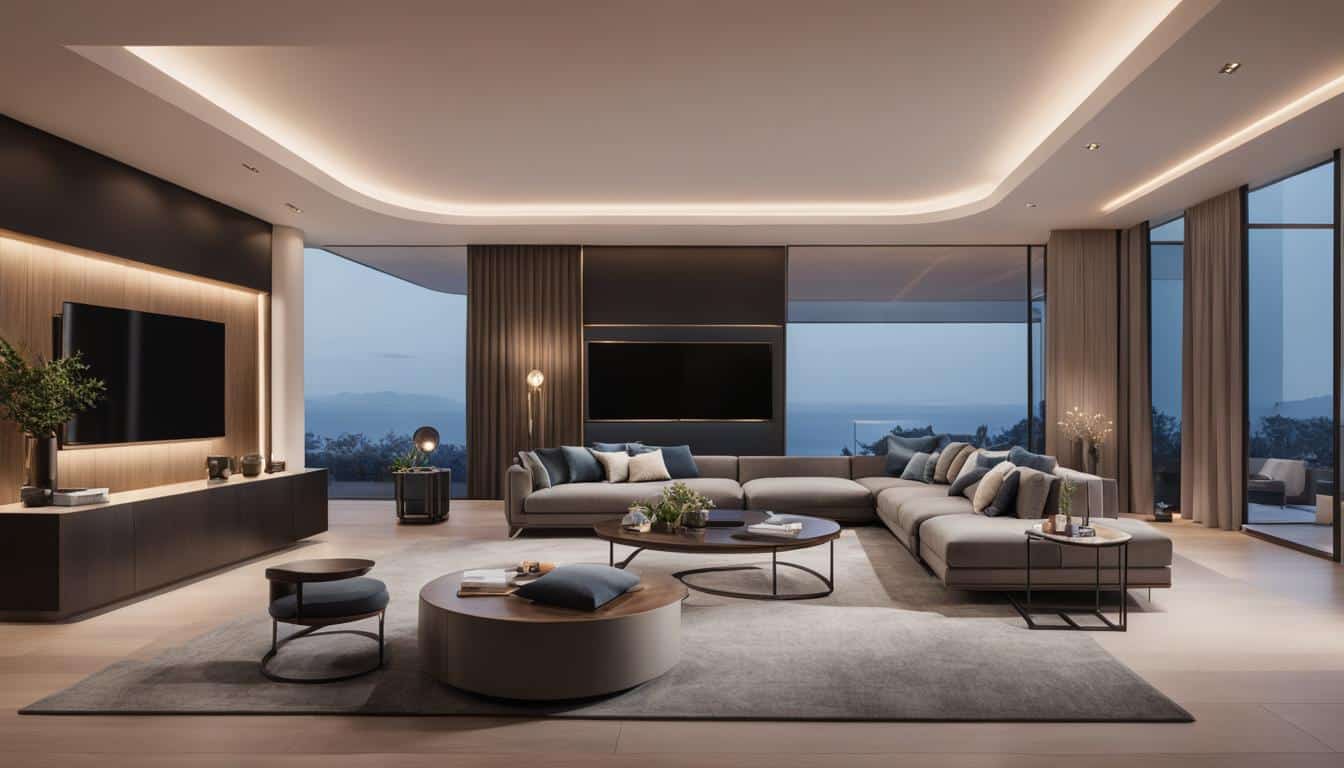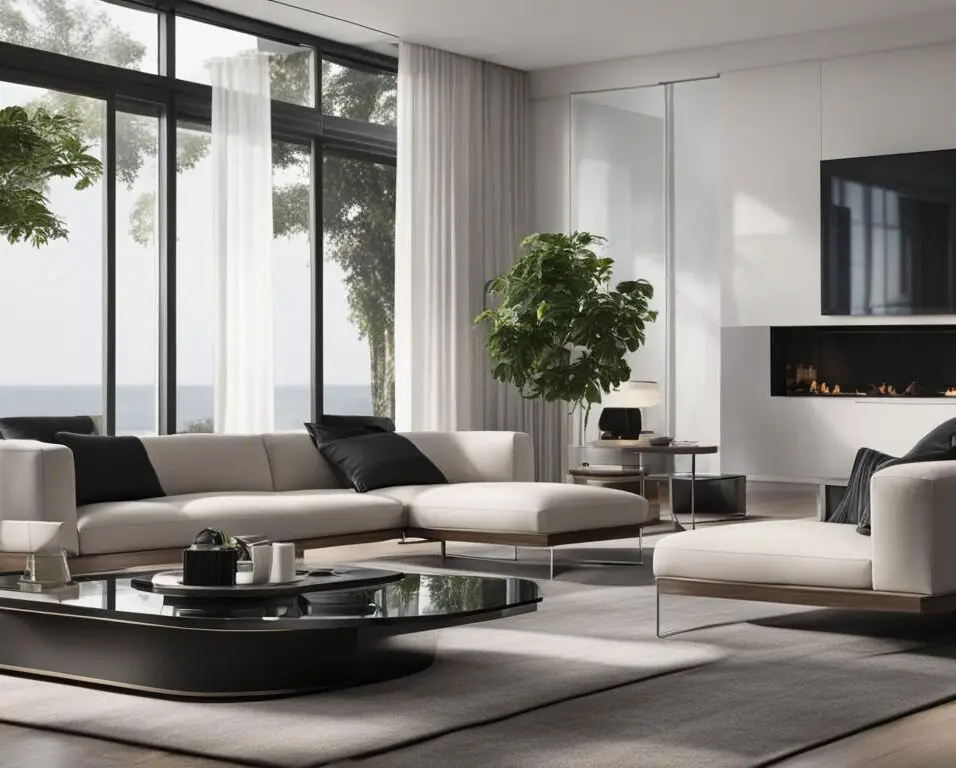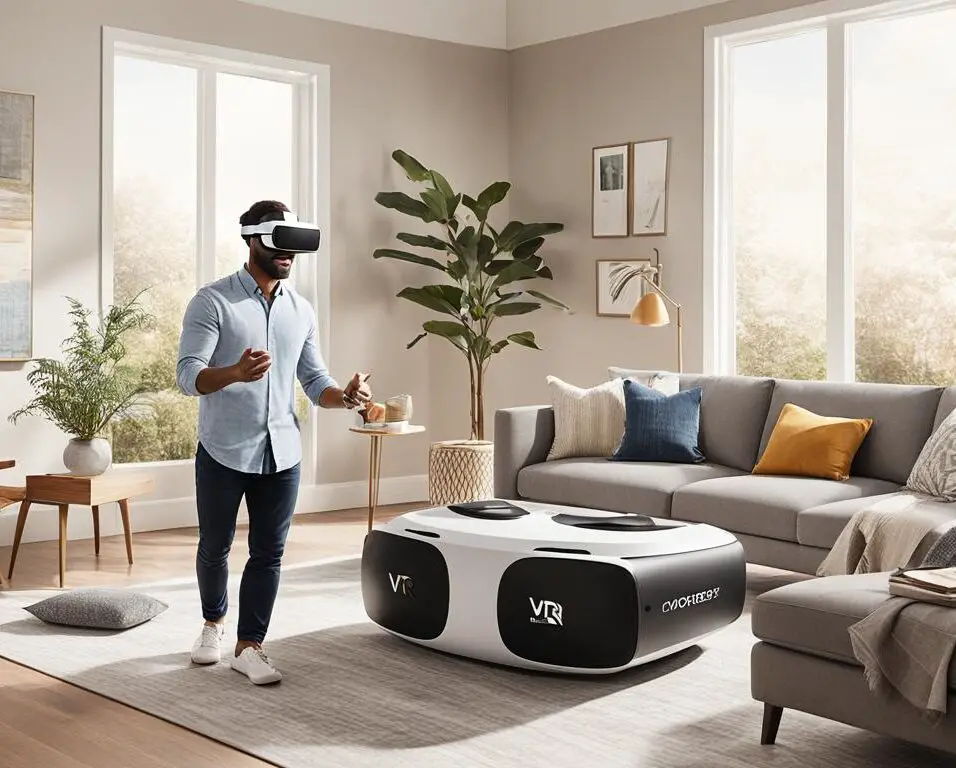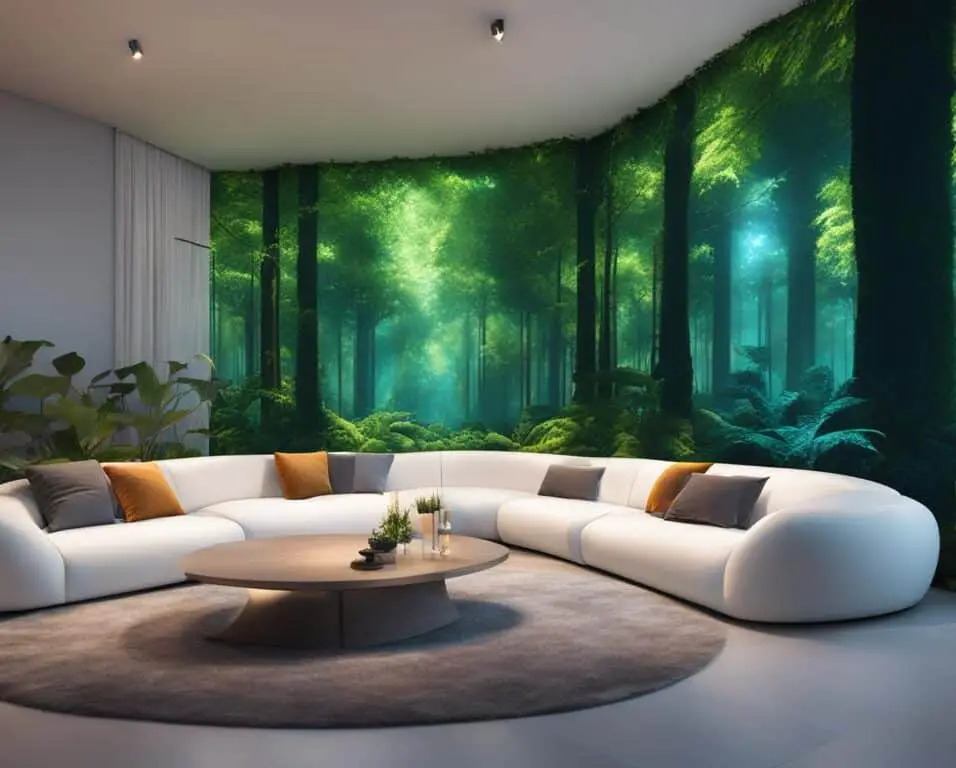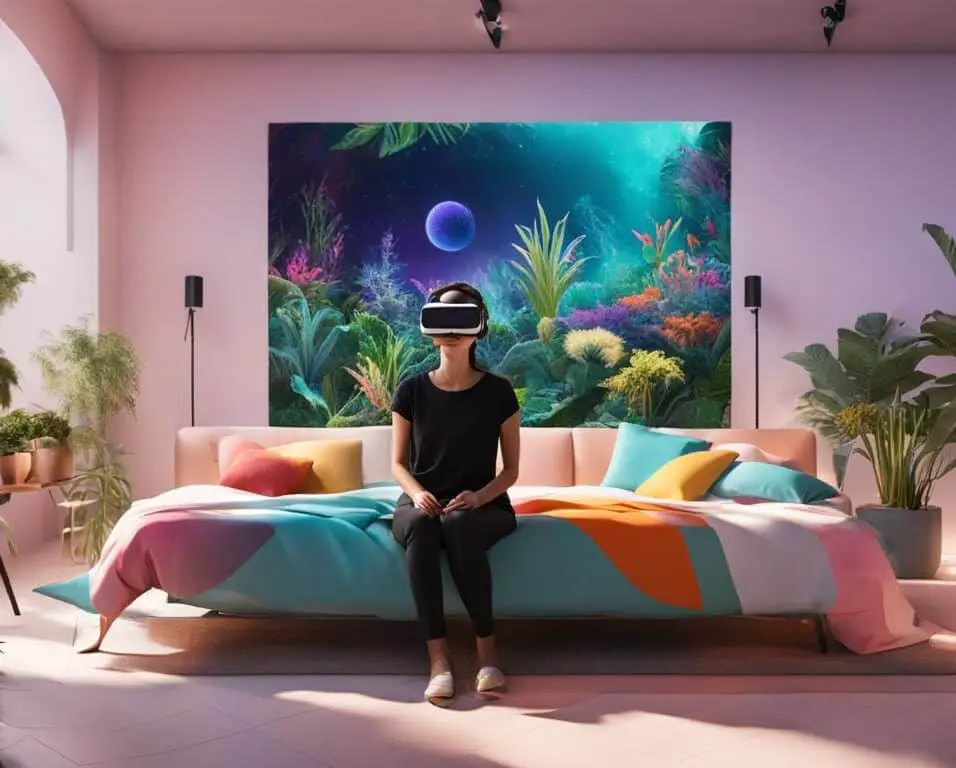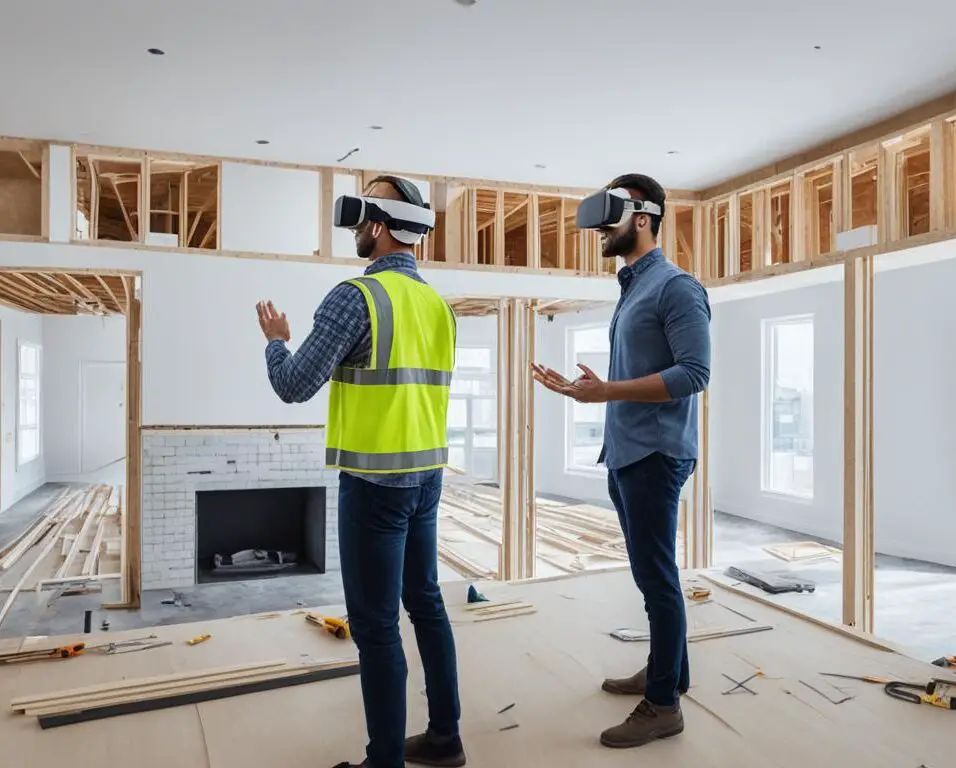Elegance Meets Tech: VR in Luxury Home Interior Design
Virtual reality (VR) technology is revolutionizing the world of luxury home interior design, bringing together elegance and technology for an unparalleled experience. With VR, homeowners can now explore the future of upscale living by visualizing their dream spaces and bringing them to life before their eyes. This article will delve into the integration of VR in luxury home interior design, exploring its benefits, applications, and the impact it has on the overall design process.
Key Takeaways:
- VR technology is transforming luxury home interior design, offering homeowners an immersive visualization of their dream spaces.
- Benefits of VR in luxury home interior design include enhanced design visualization and increased accuracy in decision-making.
- Applications of VR in luxury home interior design include virtual showrooms, real-time design modifications, and virtual staging.
- VR enhances the design process by facilitating collaboration, remote design consultations, and simplifying material selection.
- The integration of VR in luxury home interior design aligns with personalized and experiential design trends, providing customization options and seamless technology integration.
The Benefits of VR in Luxury Home Interior Design
The use of VR in luxury home interior design offers numerous advantages that enhance the overall design experience. VR provides an immersive experience, allowing homeowners to fully visualize and engage with their future spaces before construction. By virtually walking through rooms, exploring different design options, and making informed decisions, homeowners can create a personalized and exquisite living environment.
One of the key benefits of VR is its ability to provide an immersive experience. Through the use of cutting-edge technology, homeowners can step into a virtual representation of their future home and get a realistic sense of space and design. This immersive experience enables them to assess how different elements come together, giving them the confidence to make informed choices about layout, materials, and color schemes.
VR allows homeowners to fully immerse themselves in their dream spaces, enabling them to make design decisions with confidence.
In addition to the immersive experience, VR enables increased accuracy in design visualization. Designers and homeowners can collaborate to create a virtual representation of the desired interior design. This allows for precise and detailed visualization of the final result, minimizing potential errors and ensuring that the end product matches the initial vision.
Visualizing design concepts in 3D through VR technology provides an unparalleled level of accuracy and precision. Homeowners can explore every corner of their future space, examine intricate details, and make necessary adjustments in real time. This not only eliminates any uncertainties but also ensures that the final design aligns with their expectations.
Benefits of VR in Luxury Home Interior Design:
- Immersive experience that allows homeowners to fully visualize their future spaces
- Opportunity to explore different design options and make informed decisions
- Enhanced accuracy in design visualization, minimizing potential errors
| Advantages of VR in Luxury Home Interior Design | Description |
|---|---|
| Immersive Experience | Allows homeowners to fully engage with their future spaces |
| Design Visualization | Enables precise and detailed visualization of design concepts in 3D |
| Increased Accuracy | Minimizes potential errors and ensures that the final design matches the initial vision |
With the benefits of an immersive experience and increased accuracy, VR technology is revolutionizing luxury home interior design. Homeowners can now embark on a design journey that combines elegance and innovation, allowing them to bring their dream spaces to life with confidence and precision.
Applications of VR in Luxury Home Interior Design
VR technology offers a wide range of applications in luxury home interior design, revolutionizing the way homeowners can envision and bring their dream spaces to life. Let’s explore some of the key applications of VR in this context:
1. Virtual Showrooms
In virtual showrooms, homeowners can delve into a rich visual experience, exploring an extensive range of furniture pieces and decor options. From luxurious sofas and elegant dining sets to breathtaking artwork and exquisite lighting fixtures, virtual showrooms allow homeowners to virtually “walk” through various design possibilities. This immersive experience offers a realistic perspective, enabling them to visualize how different elements would look and fit together within their space. The convenience and flexibility of virtual showrooms save valuable time and effort, as homeowners can view and compare options without physically visiting multiple stores or showrooms.
2. Real-time Design Modifications
With VR technology, homeowners can experience the power of real-time design modifications. This means that while visualizing their dream spaces, they can make instant adjustments and see the changes reflected in the virtual environment. Say goodbye to the hassle of imagining how a different color scheme or furniture arrangement might look – now you can see it for yourself without any guesses or doubts. Real-time design modifications allow homeowners to experiment with various design elements, empowering them to make confident decisions about their interior design choices.
3. Virtual Staging
Virtual staging is a game-changer in the real estate industry, enhancing the market appeal of properties for potential buyers. Instead of relying solely on traditional staging methods that involve physically setting up furniture and decor, virtual staging allows homes to be digitally furnished with a few clicks. High-quality 3D models of furniture and accessories can be seamlessly integrated into the virtual environment, allowing potential buyers to see the full potential of the space. Virtual staging presents homes in their best light, helping potential buyers visualize the possibilities and making it easier for them to imagine themselves living in the space.
These applications demonstrate how VR is reshaping luxury home interior design, providing homeowners with immersive experiences and empowering them to take an active role in the design process. Whether it’s exploring virtual showrooms, making real-time design modifications, or utilizing virtual staging for increased market appeal, VR technology is revolutionizing the way we design and experience luxury interiors.
Next, we will explore how the integration of VR enhances the overall design process and collaboration in luxury home interior design.
Enhancing the Design Process with VR
Virtual reality (VR) technology has revolutionized the design process for luxury home interiors, bringing about a collaborative and efficient approach. With VR, designers, architects, and homeowners can seamlessly work together to create stunning living spaces. One of the key benefits of VR in the design process is the ability to facilitate collaboration, enabling stakeholders to provide feedback and make decisions in real-time regardless of their physical location. This fosters a more inclusive and streamlined design experience.
Through remote design consultations and virtual design reviews, all parties involved can actively participate in the decision-making process. Designers can present their ideas and visions in a virtual environment, allowing homeowners to visualize and fully immerse themselves in the proposed designs. This level of collaboration ensures that everyone’s preferences and requirements are taken into account, resulting in a more tailored and satisfactory outcome.
Furthermore, VR simplifies the material selection process, offering homeowners an extensive range of options to explore virtually. With the ability to examine and interact with different textures, finishes, and materials, homeowners can make more informed choices regarding their interior design. This not only saves time but also enhances the overall aesthetic and quality of the final design.
Overall, the integration of VR in the design process enhances collaboration, remote design consultations, and material selection. It not only allows for more effective communication between designers, architects, and homeowners but also provides an immersive and interactive experience that empowers homeowners to actively participate in the design process. With VR, the design process becomes more efficient, accurate, and inclusive.
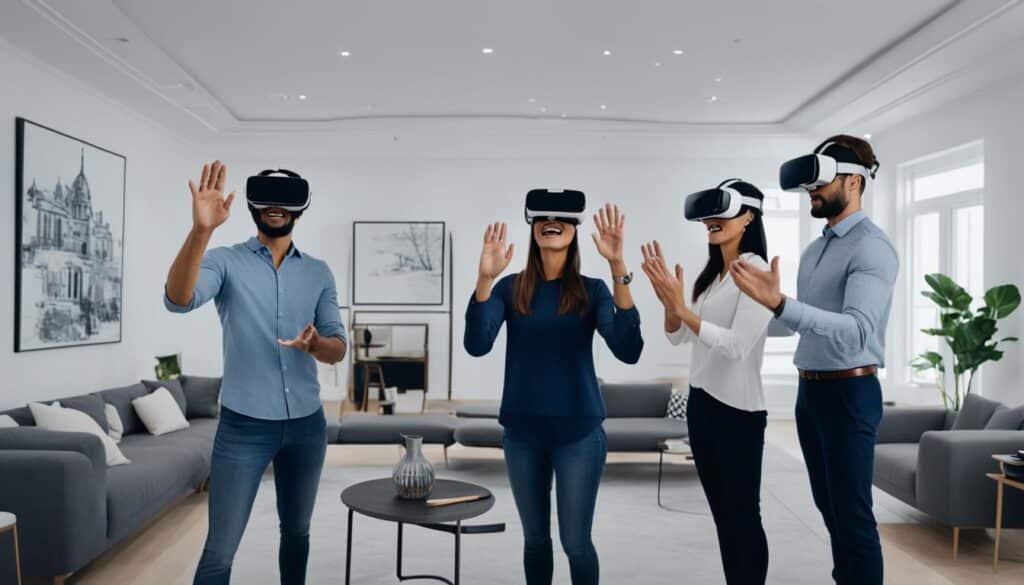
| Benefits of VR in the Design Process | Applications |
|---|---|
|
|
Luxury Home Interior Design Trends and VR Integration
The integration of VR in luxury home interior design aligns perfectly with current trends in personalized and experiential design. Homeowners now have the opportunity to customize every aspect of their interior spaces, making design choices that truly reflect their tastes and preferences. Additionally, with the increasing importance of technology integration in modern homes, VR becomes a valuable tool for seamlessly incorporating tech features into the design, such as integrated audiovisual systems or smart home automation.
Personalized Designs
With VR, homeowners can create personalized designs that cater to their unique style and preferences. They can experiment with different color schemes, furniture layouts, and decor options in a virtual environment, allowing them to visualize how each choice contributes to the overall aesthetic of their luxury home.
Customization Options
VR technology provides endless customization options for luxury home interior design. Homeowners can explore a wide range of design possibilities and experiment with various materials, finishes, and textures, helping them find the perfect combination that brings their vision to life.
Experiential Design
VR enables experiential design by allowing homeowners to virtually experience their future spaces before they are built. They can walk through virtual rooms, interact with objects, and get a sense of the atmosphere and ambience, ensuring that every detail is carefully considered and curated for an immersive and captivating living experience.
Technology Integration
As modern homes increasingly integrate technology, VR becomes a powerful tool for seamlessly incorporating tech features into luxury home interior design. Homeowners can use VR to visualize the integration of smart home automation systems, audiovisual setups, and other cutting-edge technologies, ensuring a cohesive and technologically advanced living space.
VR integration allows for a harmonious blend of personalized designs, customization options, experiential design, and technology integration, providing homeowners with a truly exceptional luxury home interior design experience.
| Benefits of VR Integration | Examples |
|---|---|
| Enhanced design visualization | Virtual tours of proposed design concepts |
| Improved collaboration | Real-time design consultations with architects and designers |
| Elevated user experience | Virtual walk-throughs of customized interior spaces |
The integration of VR in luxury home interior design opens up a world of possibilities for homeowners to create personalized, immersive, and technologically advanced living spaces. With VR, the future of luxury home interior design is not only visually stunning, but also uniquely tailored to individual tastes and preferences.
Future Possibilities of VR in Luxury Home Interior Design
The future of luxury home interior design is set to be shaped by the continuous advancements in virtual reality (VR) technology. With the integration of artificial intelligence (AI), VR experiences are expected to become even more realistic and personalized. These advancements open up a world of exciting possibilities for the industry.
One of the potential applications of VR in luxury home interior design is the inclusion of virtual reality tours as a standard part of the home buying process. Potential buyers can explore properties remotely, immersing themselves in the virtual environment and getting a feel for the spaces before making any commitments. This technology empowers homeowners by providing them with a comprehensive understanding of property layouts, design aesthetics, and overall ambiance.
In addition to virtual reality tours, VR could also be utilized for simulating smart homes. With a virtual experience of how automated systems will function, homeowners can make informed decisions about incorporating smart technologies into their living spaces. VR simulations allow for dynamic testing and customization of home automation systems, ensuring they align perfectly with the homeowners’ needs and preferences.
Advancements in Virtual Reality
The continuous advancements in VR technology will play a pivotal role in shaping the future of luxury home interior design. These advancements will provide enhanced levels of immersion, interactivity, and realism. Here are some key areas where virtual reality is evolving:
- Improved Graphics and Visuals: Virtual reality experiences will benefit from more realistic graphics and visuals. High-resolution displays and enhanced rendering techniques will create a more immersive and lifelike environment.
- Enhanced Haptic Feedback: Haptic feedback technology, which provides touch sensations, is expected to improve, allowing users to feel textures and objects within the virtual environment. This will further enhance the level of realism and sensory immersion.
- Gesture and Voice Recognition: The integration of advanced gesture and voice recognition technologies will offer more natural and intuitive ways of interacting with the virtual environment. Homeowners will be able to navigate and control their virtual spaces effortlessly.
With these advancements on the horizon, the future of luxury home interior design will undoubtedly be marked by the seamless integration of VR and AI technologies. Homeowners will be able to create personalized and immersive experiences within their living spaces, making design choices that truly reflect their preferences.
“The integration of virtual reality and artificial intelligence is transforming the way we envision and design luxury homes. It opens up a new realm of possibilities for homeowners and interior designers to create personalized spaces that exceed expectations.”
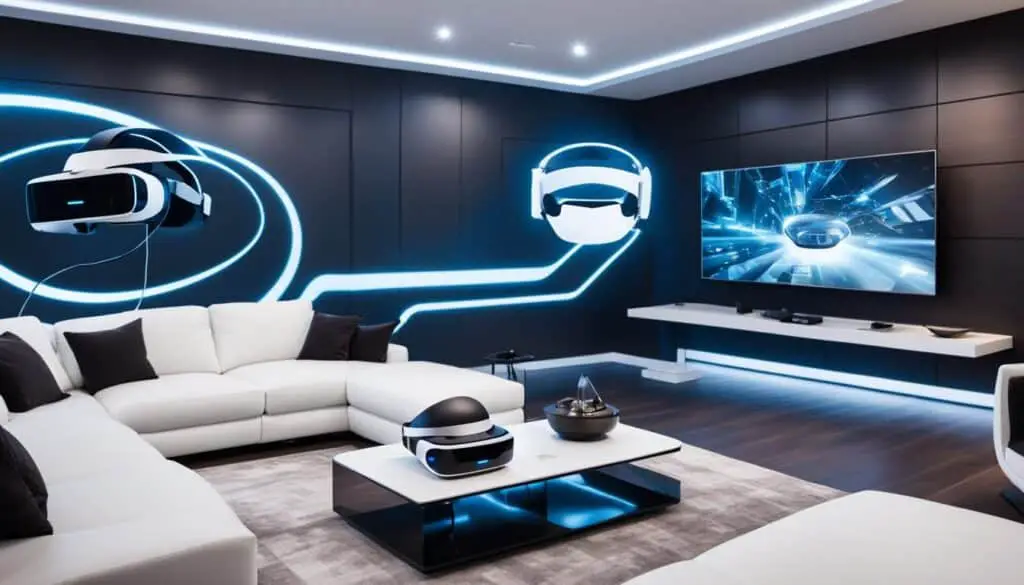
Overcoming Challenges in VR Integration
While VR technology presents numerous benefits for luxury home interior design, there are several challenges that need to be addressed for successful integration. These challenges include cost considerations, hardware requirements, and ensuring a seamless user experience.
- Cost Considerations: Implementing VR in luxury home interior design involves investing in both hardware and software. High-quality VR equipment and advanced software can be costly, making widespread implementation a potential barrier. However, as technology continues to evolve and become more accessible, the cost of VR integration is likely to decrease.
- Hardware Requirements: VR experiences rely on powerful hardware to provide realistic and immersive environments. This includes high-resolution displays, powerful processors, and accurate motion tracking systems. Homeowners and designers must ensure that their hardware meets these requirements to achieve optimal VR performance.
- User Experience: To fully leverage the benefits of VR, the user experience needs to be carefully considered. Homeowners should be able to easily navigate and interact with the virtual environment, ensuring an intuitive and enjoyable experience. Designers must prioritize user-friendly interfaces and responsive controls to enhance the overall user experience.
Despite these challenges, advancements in technology and decreasing costs are making VR integration more feasible for luxury home interior design. As designers and homeowners continue to embrace VR, these challenges are likely to diminish, unlocking the full potential of VR as a valuable tool in creating immersive and personalized interior spaces.
“Advancements in technology and decreasing costs are making VR integration more feasible for luxury home interior design.”
To understand the impact of VR integration in luxury home interior design, let’s explore some examples of successful implementations:
| Case Study | Effectiveness |
|---|---|
| Luxury Property Showcase Using VR to create virtual property tours and showcase luxury homes to potential buyers, regardless of location. |
Increased buyer engagement, expanded reach, reduced travel costs. |
| Collaborative Design Review Enabling real-time collaboration between designers, architects, and homeowners to review and make design decisions together. |
Streamlined communication, faster decision-making, improved design outcomes. |
| Material Selection Visualization Allowing homeowners to virtually explore different materials, textures, and finishes to make informed design choices. |
Enhanced creativity, reduced material waste, improved design accuracy. |
Through addressing cost considerations, optimizing hardware requirements, and prioritizing the user experience, the challenges in VR integration can be overcome. As luxury home interior design continues to evolve, VR will play a crucial role in delivering enhanced visualization and personalized experiences.
Conclusion
VR technology is revolutionizing luxury home interior design, offering homeowners the opportunity to step into their dream spaces before they even exist. The integration of VR in the design process provides enhanced visualization and a truly immersive experience, allowing homeowners to fully understand and appreciate their future living environments. With VR, collaboration between designers, architects, and homeowners is seamless, resulting in more accurate designs and efficient decision-making.
Moreover, VR in luxury home interior design caters to personalized experiences, enabling homeowners to customize every aspect of their spaces to reflect their unique tastes and preferences. This level of customization, combined with technological advancements and the seamless integration of smart home features, creates a truly luxurious and futuristic living environment.
As we look to the future, the role of VR in luxury home interior design is only set to grow. With ongoing advancements in technology, the possibilities are endless. We can anticipate AI integration, virtual reality tours becoming a standard part of property viewing, and even virtual simulations of smart homes. The future of upscale living holds exciting prospects for those looking to blend cutting-edge technology with impeccable design.
FAQ
What is the benefit of using VR in luxury home interior design?
Virtual reality technology provides an immersive experience that allows homeowners to fully visualize and experience their future spaces. They can virtually walk through rooms, explore different design options, and make informed decisions regarding layout, materials, and color schemes.
In what ways can VR be applied in luxury home interior design?
VR technology can be used to create virtual showrooms where homeowners can view different furniture pieces and decor options in a realistic virtual environment. It also enables real-time design modifications, allowing homeowners to see immediate changes in the design and adjust accordingly. VR can also be utilized for virtual staging, enabling potential buyers to visualize a fully furnished home.
How does VR enhance the design process of luxury home interiors?
VR facilitates collaboration between designers, architects, and homeowners by allowing them to engage in virtual design reviews and provide feedback in real time, even if they are physically located in different places. It also simplifies the material selection process by allowing homeowners to virtually explore different textures, finishes, and materials.
How does the integration of VR align with current trends in luxury home interior design?
The integration of VR aligns with trends in personalized and experiential design, as it allows homeowners to customize every aspect of their interior spaces and make design choices that reflect their tastes and preferences. It also enables the seamless incorporation of technology features into the design, such as integrated audiovisual systems or smart home automation.
What are the future possibilities of VR in luxury home interior design?
With ongoing advancements in technology, the future of VR in luxury home interior design looks promising. The integration of artificial intelligence (AI) can make VR experiences even more realistic and personalized. Virtual reality tours could become a standard part of the home buying process, allowing potential buyers to explore properties remotely. VR could also be utilized for simulating smart homes, providing homeowners with a virtual experience of how their automated systems will function.
What challenges need to be overcome in the integration of VR in luxury home interior design?
Cost considerations, including investment in hardware and software, may limit widespread implementation of VR technology. Additionally, the user experience needs to be carefully considered to ensure homeowners can easily navigate and interact with the virtual environment. However, as technology becomes more accessible, these challenges are likely to diminish.



